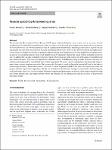Item Infomation
Full metadata record
| DC Field | Value | Language |
|---|---|---|
| dc.contributor.author | Pritom, Ahmed | - |
| dc.contributor.author | Ahmed, Eldawy | - |
| dc.contributor.author | Vagelis, Hristidis | - |
| dc.date.accessioned | 2023-04-25T03:09:05Z | - |
| dc.date.available | 2023-04-25T03:09:05Z | - |
| dc.date.issued | 2022 | - |
| dc.identifier.uri | https://link.springer.com/article/10.1007/s00778-022-00759-9 | - |
| dc.identifier.uri | https://dlib.phenikaa-uni.edu.vn/handle/PNK/8266 | - |
| dc.description | CC BY | vi |
| dc.description.abstract | We introduce the R everse S patial Top-k K eyword (RSK) query, which is defined as: given a query term q, an integer k and a neighborhood size find all the neighborhoods of that size where q is in the top-k most frequent terms among the social posts in those neighborhoods. An obvious approach would be to partition the dataset with a uniform grid structure of a given cell size and identify the cells where this term is in the top-k most frequent keywords. However, this answer would be incomplete since it only checks for neighborhoods that are perfectly aligned with the grid. Furthermore, for every neighborhood (square) that is an answer, we can define infinitely more result neighborhoods by minimally shifting the square without including more posts in it. To address that, we need to identify contiguous regions where any point in the region can be the center of a neighborhood that satisfies the query. We propose an algorithm to efficiently answer an RSK query using an index structure consisting of a uniform grid augmented by materialized lists of term frequencies. | vi |
| dc.language.iso | en | vi |
| dc.publisher | Springer | vi |
| dc.subject | spatial top-k keyword queries | vi |
| dc.title | Reverse spatial top-k keyword queries | vi |
| dc.type | Book | vi |
| Appears in Collections | ||
| OER - Công nghệ thông tin | ||
Files in This Item:

